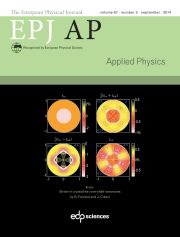Article contents
A study of the behavior of a d.c. pulsed low pressure point-to-plane discharge
Published online by Cambridge University Press: 14 May 2003
Abstract
A numerical study of a nitrogen cold plasma created by a pulsed discharge in a point-to-planegeometry at 4 torr is presented. The relative model is based on fluid description of the cold plasma, on Poisson's equation for the electric field and on balance equations for the excitedpopulation concerning only some vibrational band of molecular nitrogen (C3∏u, B3∏g and A $^3\sum_{\rm u}^+$  ).Secondary ionization phenomena and longitudinal diffusion effects are included in the model and their contribution to the glow-discharge establishment is studied. Results for space and timevariations of the charged particles, electric field, potential and electronic current densities arereported. Particular attention was paid to the physical factors forming the cathodic layer andinfluencing its evolution. Results concerning the influence of the electronic current density on thecreation of excited (radiative and metastables) particles are presented.According to these results, the plasma of the glow discharge occurs by means of three successivesequences with different characteristics. During the first sequence the gap is slowly filled of ionsformed close to the anode, then in the second one an ionizing front formed close to the anode ispropagating towards the cathode with an average velocity of 2 × 106 cm/s. It forms the cathodic layer zone and starts the participation of the secondary ionization effects leading to the thirdsequence which deals with the glow discharge establishment. The first significant production ofexcited states occurs within the ionizing front but the most important one is obtained when theglow discharge is established. It has been shown that at 4 torr and a gap of 1 cm, a meanelectronic current density of 5 mA/cm2 is sufficient to create 109 cm−3 of (B3∏g, v = 0), 108 cm−3 of(C3∏u, v = 0) and 1011 cm−3 of (A $^3\sum_{\rm u}^+$
).Secondary ionization phenomena and longitudinal diffusion effects are included in the model and their contribution to the glow-discharge establishment is studied. Results for space and timevariations of the charged particles, electric field, potential and electronic current densities arereported. Particular attention was paid to the physical factors forming the cathodic layer andinfluencing its evolution. Results concerning the influence of the electronic current density on thecreation of excited (radiative and metastables) particles are presented.According to these results, the plasma of the glow discharge occurs by means of three successivesequences with different characteristics. During the first sequence the gap is slowly filled of ionsformed close to the anode, then in the second one an ionizing front formed close to the anode ispropagating towards the cathode with an average velocity of 2 × 106 cm/s. It forms the cathodic layer zone and starts the participation of the secondary ionization effects leading to the thirdsequence which deals with the glow discharge establishment. The first significant production ofexcited states occurs within the ionizing front but the most important one is obtained when theglow discharge is established. It has been shown that at 4 torr and a gap of 1 cm, a meanelectronic current density of 5 mA/cm2 is sufficient to create 109 cm−3 of (B3∏g, v = 0), 108 cm−3 of(C3∏u, v = 0) and 1011 cm−3 of (A $^3\sum_{\rm u}^+$  , v = 0) excited particles.
, v = 0) excited particles.
Information
- Type
- Research Article
- Information
- Copyright
- © EDP Sciences, 2003
References
- 8
- Cited by

